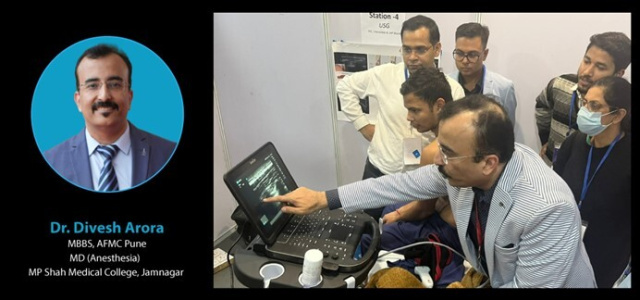
Dr.Divesh Arora, Head – Operation Theater & Anesthesia department at renowned Asian Institute of Medical Science, Faridabad, recently shared his journey of point-of-care ultrasound & its significance in his routine clinical practice.
Introduction to FUJIFILM Sonosite
My first tryst with ultrasound happened in 2007 where I got to learn for the first time that ultrasound could be used for wide variety of purposes in anesthesia practice. Those were early years where Sonosite was finding ways to expand its footprint in the Indian healthcare space, and we were fortunate that our hospital administration understood the need and we procured Sonosite Titan for our ICU and operating room. With time, we expanded its usage from vascular access to ultrasound-guided regional anesthesia and now utilizing ultrasound for perioperative clinical applications. As years passed, we upgraded from Sonosite Titan to Sonosite M-Turbo and currently we have added Sonosite Edge II in our department.
Blind Landmark techniques to ultrasound-guided regional anesthesia
During our initial days (prior to adopting ultrasound) we used to perform regional nerve blocks through landmark technique seeking paresthesia and later migrated to PNS-guided nerve blocks. But these modalities were associated with delayed onset of blocks at times and a few failures also. Later ultrasound helped us to identify neural structures, guided us with correct placement of local anesthetic in the vicinity of nerve and helped us to reduce the volume of local anesthetic used and thereby increased success rates, boosted our confidence, and patient’s satisfaction. Adoption of a compact ultrasound machine revolutionized central venous line insertions, and soon it was included in our guidelines as a tool for insertion of CVP lines. Now ultrasound daily helps us in accurate identification of landmarks for line insertions as well for performing almost all regional anesthesia nerve blocks.
Role of point-of-care ultrasound in routine practice at AIMS Hospital, Faridabad
We anesthesiologists are perioperative physicians where we have to deal with comorbidities involving the central nervous system, cardiovascular system, respiratory system to name a few. Point-of-care ultrasound (POCUS) helps clinicians at the bedside of patients for both diagnostic as well as procedural work. POCUS has extensively helped me in my clinical practice for improving patient outcomes and at times it has emerged as a lifesaving tool for the patient.
Currently we are using Sonosite EDGE II ultrasound system for central line placement, arterial lines, and in difficult peripheral venous access cases. We also routinely use this compact and easy to use ultrasound system for performing regional nerve blocks, echocardiography, airway, diaphragm, gastric and venous doppler applications. Perioperative POCUS is very useful in identifying patients with inadequate NPO status posted for emergency surgery and helps anesthesiologists correctly identify residual stomach contents and take appropriate measures to protect patients from aspiration. POCUS is also helpful in identifying cause of hypotension and hypoxemia which can occur in patients undergoing complex and long duration surgeries associated with blood loss.
Interesting case study
I would like to highlight one case wherein an obese patient with BMI of 38 was scheduled for second stage cosmetic procedure. The first surgery was uneventful, which had happened 5 days prior. On patient evaluation for second surgery, we found the patient tachypneic with oxygen saturation of 90%. The chest examination was unremarkable. We scanned his femoral veins and to our surprise they were non-compressible on the left side signifying acute deep vein thrombosis which could explain hypoxemia. Then urgent cardiologist help was sought, surgery was deferred, and patient was treated for DVT.
Pledged to educate POCUS
When I started ultrasound practice there were minimal educational resources available to learn this fascinating modality. As I gradually learnt ultrasound with time and when I became proficient in using it, I pledged to myself that I will do everything to make understanding of ultrasound-guided regional anesthesia easy for the generations to come. Since very beginning of 2015 we started organizing CME cum workshops titled Focused Approach to Regional Anesthesia (FARA) at Asian Hospital, Faridabad. And since, 2021, we have also been successfully running a regional anesthesia observer ship program accredited by the prestigious Academy of Regional Anesthesia (AORA) where candidates from all over India come to learn and update themselves in Regional Anesthesia skills.
I believe that ultrasound technology has enormous potential with innumerable benefits, and it should be adopted by every point-of-care physician in their routine clinical practice.


